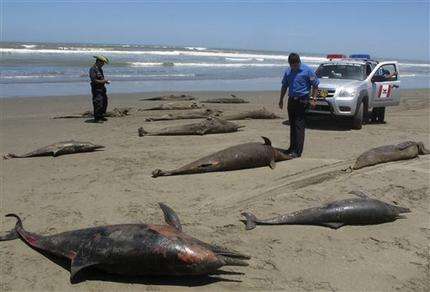Official: Dolphin deaths in Peru still a mystery

(AP) -- Peruvian authorities are still trying to unravel the mystery of why hundreds of dolphins ended up dead on beaches in the country over the past 2 1/2 months.
Deputy Environment Minister Gabriel Quijandria told The Associated Press in an interview on Friday that studies are incomplete but officials hope to complete their research on the likely causes next week.
He said that the carcasses of 877 dolphins and porpoises were found between February and mid-April on the beaches of northern Peru. About 90 percent were long-beaked common dolphins, while others were Burmeister porpoises, Quijandria said.
"The most probable hypothesis is the possibility of an infection with a virus," he said. "There are scientific articles about the incidence of morbillivirus, a type of distemper, in cetaceans in Peru, and that can be ruled out or proven next week."
He said officials don't believe the dolphins' deaths are related to seismic oil exploration work that was carried out off northern Peru between Feb. 8 and April 8 by the Houston-based company BPZ Energy.
Rafael Zoeger, the company's manager in Peru, said the seismic studies were carried out using a ship that fired discharges of compressed air toward the sea floor. It's customary for oil companies to carry out such surveys with air-guns that emit sounds and send out underwater pulses. Zoeger said the company does not believe the dolphins died due to the oil exploration work.
The Peruvian environmental group Orca has said that sound waves from the seismic work appeared to be the likely cause.
But Quijandria said that "so far there is no evidence linking the deaths of the dolphins to the seismic work."
Hundreds of dolphins have at times turned up dead on beaches in various parts of the world, though the number of dolphins counted in northern Peru was particularly high. Quijandria said the country hasn't seen such a large die-off of dolphins in recent years.
He said Peru hopes to receive help from experts at the U.S. National Oceanic and Atmospheric Administration in studying whether the dolphins and porpoises had some sort of virus.
Researchers elsewhere are studying the effects on marine mammals of the air-guns used in seismic studies. But George Ioup, a physics professor at the University of New Orleans, said "it's pretty much an open question at this point... whether harm is caused to the animals."
Katie Moore, manager of marine mammal rescue and research for the International Fund for Animal Welfare in Yarmouth Port, Massachusetts, said some areas in the world tend to be hotspots for mass strandings of whales or dolphins, from Cape Cod to Australia and New Zealand.
"This winter we had an event involving over 200 common dolphins here on Cape Cod," Moore said. "We experience mass strandings several times each year. The events may involve only a few animals or hundreds. The causes of these events are often not determined, which is a frustrating fact."
©2012 The Associated Press. All rights reserved. This material may not be published, broadcast, rewritten or redistributed.

















